W4SM's "Unofficial" Web Page
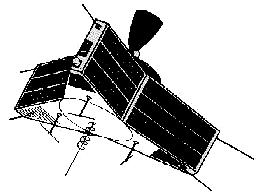
W4SM's "Unofficial" Web Page

The Real Thing Prior to Launch
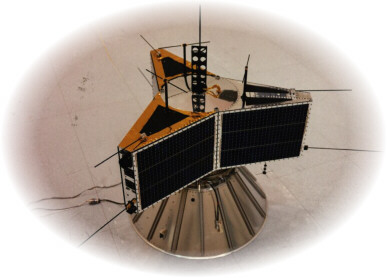
Thanks to Paul Willmott for sending the drawing of AO-10 now shown above, to James Miller for pointing out that the AO-13 drawing initially shown was just the AO-10 drawing with an S-band helix added in, and to Peter Guelzow for pointing me to the Amsat-DL Web site from which the above picture was obtained.
I'll use this site to post what is currently known, estimated, or "guesstimated" regarding AO-10. As time permits, a more complete history of AO-10 will be added.
Current Status: 2002-11-28
AO-10 appears to be VERY slowly tumbling. Because of the
apparent tumbling of AO-10 no predictions can be generated about solar
angles, squint angles, or functionality. If/when the antenna and solar
angles are appropriate, AO-10 will spring back to life. I get several e-mails
a week asking me if AO-10 is operational. Because of my activity with AO-40,
I seldom have time to check AO-10 and I am not the right person to answer
this question. The best approach is to post a message to the AMSAT bulletin
board. I have not seen mention of AO-10 activity on the board for quite
some time. Please don't ask me when AO-10 will be active again.... my crystal
ball is nonfunctional. The best bet is to listen for the constant carrier
beacon for a protracted period of time (1/2 hour). If you hear it, try
an uplink, and report your findings to the AMSAT bulletin board.
.
"SEE" AO-10's weak beacon during a sleep period with digital signal processing.
Even though you could not hear the beacon during this time, it was there very weakly, as several individuals demonstrated using digital signal processing. To view a gif file screen image of the beacon's output using FFTDSP software Click Here. This file was obtained by Mike West / WL7BQM.
Current "Solar" Eclipses
AO-10 will continue to experience solar eclipses around perigee into late March 2000. During periods when the earth's shadow shades AO-10, the transponder and beacon go dead almost instantly due to the lack of functional batteries.
Last "Lunar" Eclipse
On 1999-02-16 beginning at 0750 UTC, AO-10 had its sunlight almost completely blocked by the moon (82% occlusion) when it was at MA 00-06. Unfortunately, the satellite was "sleeping" at the time, so this effect could not be documented. The next lunar eclipse for AO-10 will be on 2000/02/05 and will be approximately 55% maximum occlusion. ...more later.
Antenna Configuration
As noted above, AO-10 currently seems to be using its hi-gain antennas. When the switch to the hi-gains may have occurred is unclear. The change was presumably caused by a "bit glitch" affecting the antenna latching relay. Listening to the beacon will occasionally demonstrate short runs of nonsensical PSK telemetry, indicating that there are "instabilities" in the system.
AO-10's Argument of Perigee
Because of AO-10's relatively low inclination, its argument of perigee changes much more rapidly than did AO-13's. The current value is 357.4 degs, placing apogee close to the equator and just within the northern hemisphere. The ArgP has been increasing at about 0.26 degs/day and will soon cross into the southern hemisphere, where it will remain for almost the next two years.
Brief History
AO-10 was was launched on 1983,06,16 on an Ariane-2 rocket from Kourou, French Guiana. Early minor problems precluded reaching a high (Molniya orbit) inclination and an inclination of 26 degs was obtained. The orbit of AO-10 is highly stable (ie. 100's of years) and the satellite will not suffer the re-entry fate of AO-13. Rad-hardened RAM memory was not available for AO-10's IHU and it failed due to high levels of radiation in December 1986. Since that time the S/C has been uncontrolled and its Z-axis spin rate has been slowly decreasing. It remains in Mode-B, and currently appears to be using the hi-gain antennas. The onboard batteries have failed "open" and AO-10's power is solely derived from the solar panels. When the S/C enters eclipse, the transponder fails immediately.
Why does AO-10 Periodically "Sleep"?
AO-10's twice yearly "sleeps" when it was still in essentially stable spin mode were not due to solar eclipses. A solar eclipse, from the satellite's point of view, occurs when the earth comes between the satellite and the sun. This does indeed happen during certain seasons of the year on virtually every orbit, but for rather short periods of time. The phenomenon happening with AO-10's sleeps is related to the fact that spin-stabilized satellites always point at the same spot in space (allowing for minor perturbations). As the satellite, along with the earth, rotates around the sun, the sun, appears to the satellite to rotate around it. If the orientation isn't changed, and assuming ALAT is within the range of the ecliptic (solar plane) then twice a year the sun will hit either the antenna end or the motor end of AO-10. During this time, the solar panels will be in darkness, or at least at light levels insufficient for adequate power generation. However, there's sun on the END of the satellite, so it's not in an eclipse. The batteries on AO-10 are totally dead.... when it goes into a true eclipse it instantly loses power and power/transponder instantly returns a bit later (minutes) when the satellite emerges from the earth's shadow.
Why not use AO-10 when signals are "FMing?"
The chances of damaging AO-10 by uplinking during "FMing" are probably remote. The caution mainly stems from a theoretical consideration. AO-10's latching relays are currently set to the hi-gain antenna and the transponder is on in Mode-B configuration. Each time there's a power spike the chance exists that the IHU could have a "seizure" and blurt out a pulse to switch the antennas, switch the transponder off or whatever. Of course these spikes occur every time we come out of eclipse, but the idea is to do what we can to minimize the number of power spikes. Occasionally spikes have "activated" the IHU in the past and caused the beacon to send out nonsensical data rather than the current constant carrier for short periods of time. One of these spikes in the last year or so apparently switched AO-10 to the hi-gain antenna, so such things can happen. I suppose there are also some considerations regarding the effects on the transponder of operating it so far off its normal voltage/current curve, but, again, this doesn't seem to have caused a problem after many years.
AO-10's ALON/ALAT
Because it's IHU has been dead for many years, AO-10's attitude cannot be precisely determined. However, it's orbit is well known and if we assume that at the mid point of its "sleep" cycles, one end of the S/C is pointed directly at the sun, we can guesstimate an ALON/ALAT. These calculations may be off by at least +/- 20 degs. Also, we don't know, based on illumination alone, which end is pointing at the sun, so the ALON/ALAT's given could be reversed (ALON +/-180, ALAT change sign). For example, a well documented deep sleep cycle seemed to have it's low point on about 5/25/97. On that date the sun was at SAZ(ALON)=158, SEL(ALAT)=47 with respect to AO-10's orbital plane. Thus, if the satellite were pointing directly at the sun on 5/25/97, it's ALON/ALAT would have been 158/47. I have not attempted to recalculate an ALON/ALAT more recently. As noted above, AO-10 appears to no longer be attitudinally stable and its very slow rate of rotation appears to have resulted in tumbling. Thus, attitude can no longer be determined.
James Miller (G3RUH) has developed a suite of software programs running on the Acorn Risc Computer systems for commanding and orienting AO-13 and other P3 satellites. I have modified and "ported" many of his routines to run in Windows format on PC-type machines, and to allow use with multiple satellites. The following Tables were derived from my modifications of James' software. Any errors are mine.
The chart below shows the effect of ALON/ALAT on solar illumination on 1998,03,28. The center of the "hole" at the upper right is approx. ALON/ALAT 70/30 may be thought of as the sun's position (Saz/Sel). The "mirror" hole is at the reciprocal values of ALON/ALAT 250/-30. The numbers listed are the sun's angle on the solar panels (0 = directly overhead, maximum illumination). Negative numbers indicate the sun favoring the antenna end of the satellite. Positive numbers mean the sun is towards the motor end.
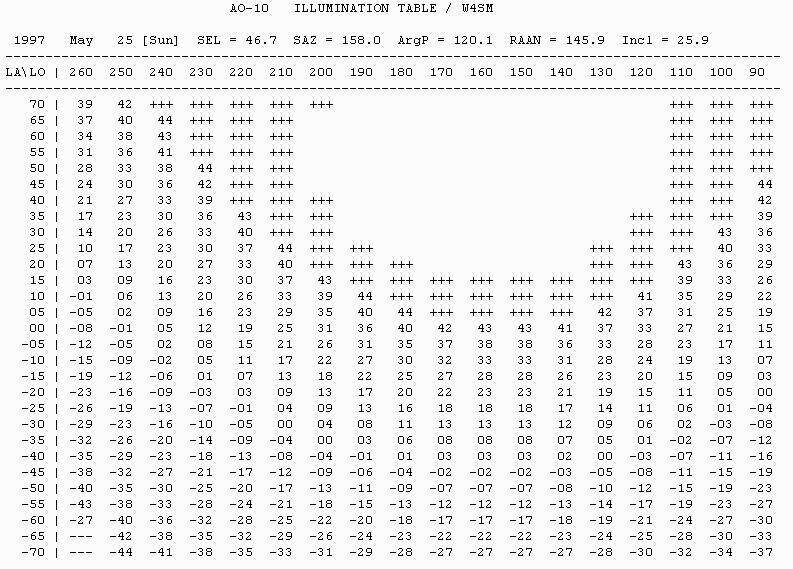
A spin stabilized satellite should always point at the same place in the celestial plane. ALON/ALAT, however, is based on orbital plane coordinates, so as the orbit changes, primarily due to precession of RAAN and ArgP, the values of ALON/ALAT change, even though the S/C is still pointing at the same celestial point.
The table below shows the weekly effect of orbital precession on AO-10's ALON/ALAT, given an ALON/ALAT of 135/32 on 1998,03,29. Note that the illumination drops off rapidly over the next few weeks.
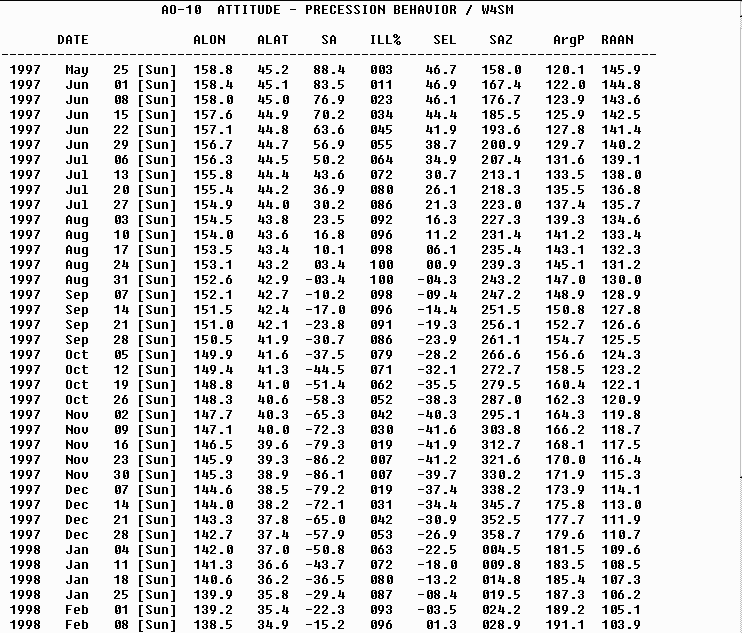
AO-10's Spin Rate
When I measured the spin rate of AO-10 in 1996, it appeared to be approximately 1.5 RPM. This was based on observations that I were made on multiple occasions, using the QSB cycles of the beacon. When the attitude of AO-10 is such that the antenna is partially blocked by the S/C, the QSB was coming in 13+ second intervals. Two of the intervals were exactly the same in duration and depth, the third is distinctly different. The repetition of this cycle was convincing that a set of three fades = 1 revolution, not 3 revolutions. Thus 1/(13 secs * 3)/60 = 1.5 RPM. The three fades/revolution are due to the tri-lobed shape of AO-10. The reason for the dissymmetry of one fade was not clear, but may be related to damage sustained when AO-10 struck a portion of its launcher early in its life. As discussed below, the spin rate of AO-10 appears to be slowing even further.
Why has AO-10's Spin Rate Decreased?
The best reason for this is "magnetic damping" as the conductive body of the S/C crosses the earth's magnetic field lines, especially around perigee. The phenomenon was quite pronounced with AO-13, because of its lower perigee.
"See" AO-10's Current Spin Rate
Even though AO-10's beacon signals are often not detectable by usual means during sleep periods, they can be detected with more sophisticated signal processing software. Masahiro Arai has been plotting AO-10's spin rate based on fluctuations in beacon signals using the FFTDSP software package. His data show that the spin period of AO-10 appears to have increased from September 1998 to through May 1999. Masahiro's Images.
A Typical AO-10 Lunar Eclipse
AO-10 is occasionally eclipsed by the moon rather than by the earth, the much more common occurrence discussed above.
This Table outlines a typical lunar eclipse, which affected
AO-10 on 1998,08,22. A maximum eclipse of 36% was reached, but since the
eclipse occurred near perigee, it lasted less than 15 minutes. Times are
in UTC.
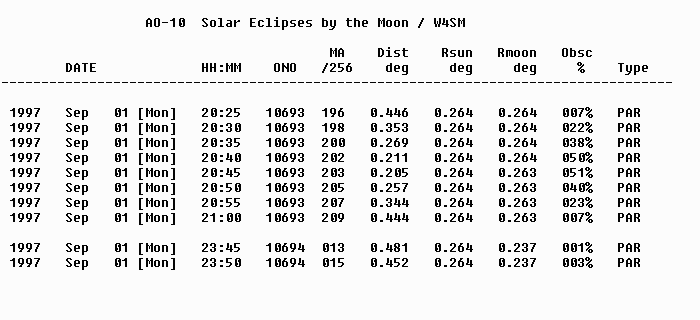
Typical AO-10 QSO
What does an AO-10 downlink sound like if you've never heard it before? "Click here to download a short "wav" file of an AO-10 QSO courtesy of Tony Bombardiere - AB2CJ.
AO-10 MODE-B TRANSPONDER
AO-10 SMOOTHED KEPLERIAN ELEMENTS